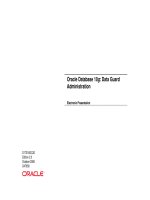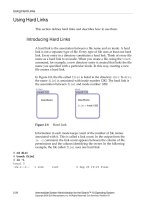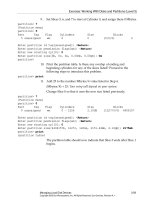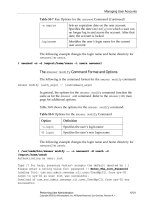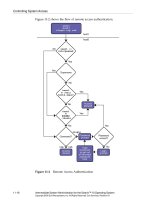D47658-Oracle dataguard student guide
Bạn đang xem bản rút gọn của tài liệu. Xem và tải ngay bản đầy đủ của tài liệu tại đây (3.82 MB, 300 trang )
Oracle Database 10g: Data Guard
Administration
Electronic Presentation
D17316GC20
Edition 2.0
October 2006
D47658
®
Copyright © 2006, Oracle. All rights reserved.
Disclaimer
This document contains proprietary information and is protected by copyright and
other intellectual property laws. You may copy and print this document solely for your
own use in an Oracle training course. The document may not be modified or altered in
any way. Except where your use constitutes "fair use" under copyright law, you may
not use, share, download, upload, copy, print, display, perform, reproduce, publish,
license, post, transmit, or distribute this document in whole or in part without the
express authorization of Oracle.
The information contained in this document is subject to change without notice. If you
find any problems in the document, please report them in writing to: Oracle University,
500 Oracle Parkway, Redwood Shores, California 94065 USA. This document is not
warranted to be error-free.
Restricted Rights Notice
If this documentation is delivered to the United States Government or anyone using
the documentation on behalf of the United States Government, the following notice is
applicable:
U.S. GOVERNMENT RIGHTS
The U.S. Government’s rights to use, modify, reproduce, release, perform, display, or
disclose these training materials are restricted by the terms of the applicable Oracle
license agreement and/or the applicable U.S. Government contract.
Trademark Notice
Oracle, JD Edwards, PeopleSoft, and Siebel are registered trademarks of Oracle
Corporation and/or its affiliates. Other names may be trademarks of their respective
owners.
Author
Donna K. Keesling
Technical Contributors
and Reviewers
Christopher D. Andrews
Harald van Breederode
Larry Carpenter
Michael Cebulla
Joel Goodman
Editors
Arijit Ghosh
Daniel Milne
Graphic Designer
Satish Bettegowda
Publishers
Srividya Rameshkumar
Jobi Varghese
Copyright © 2006, Oracle. All rights reserved.
Oracle Data Guard: Overview
Copyright © 2006, Oracle. All rights reserved.
1 - 2
Objectives
After completing this lesson, you should be able to do the
following:
• Describe the factors that affect planned and unplanned
downtime
• Describe the basic components of Oracle Data Guard
• Explain the differences between physical and logical
standby databases
• Explain the benefits of creating a Data Guard
environment
• Explain the use of Data Guard in high-availability
architectures
Copyright © 2006, Oracle. All rights reserved.
1 - 3
Causes of Data Loss
Source: Disaster Recovery Journal
Natural disasters
3%
Software corruption
4%
Computer viruses 7%
Human errors 36%
Hardware & system errors 49%
Copyright © 2006, Oracle. All rights reserved.
1 - 4
Understanding the Causes of Downtime
Planned
downtime
Unplanned
downtime
System
changes
Data
changes
Data
failures
Computer
failures
Corruption
Human
error
Site
failure
Storage
failure
Copyright © 2006, Oracle. All rights reserved.
1 - 5
What Is Oracle Data Guard?
Primary
database
Standby
database
Database Database
copy
Redo transport
Oracle Net
Copyright © 2006, Oracle. All rights reserved.
1 - 6
Types of Standby Databases
There are two types of standby databases:
• Physical standby database
– Identical to the primary database on a block-for-block
basis
– Synchronized with the primary database through
application of redo data received from the primary
database
• Logical standby database
– Shares the same schema definition
– Synchronized with the primary database by transforming
the data in the redo received from the primary database
into SQL statements and then executing the SQL
statements
Copyright © 2006, Oracle. All rights reserved.
1 - 7
Oracle Data Guard Broker Framework
CLI management client
Enterprise Manager
Repository
Primary
database
Data
Guard
broker
Oracle
Management
Server
Data
Guard
broker
Agent
Standby
database
Agent
Copyright © 2006, Oracle. All rights reserved.
1 - 8
Types of Services
There are three types of services provided with Data
Guard:
• Redo transport services
• Log apply services
– Redo Apply
– SQL Apply
• Role-management services
Copyright © 2006, Oracle. All rights reserved.
1 - 9
Role Transitions: Switchover and Failover
• Oracle Data Guard supports two role-transition
operations:
– Switchover
—
Planned role reversal
—
Used for OS or hardware maintenance
– Failover
—
Unplanned role reversal
—
Use in emergency
—
Zero or minimal data loss depending on choice
of data protection mode
—
Can be initiated automatically when fast-start failover is
enabled
• Role-transition operations are not automatically
invoked.
Copyright © 2006, Oracle. All rights reserved.
1 - 11
Data Protection Modes
• Maximum protection
• Maximum availability
• Maximum performance
Copyright © 2006, Oracle. All rights reserved.
1 - 13
Benefits of Implementing
Oracle Data Guard
Oracle Data Guard provides the following benefits:
• Continuous service through disasters or crippling data
failures
• Complete data protection against corruptions and data
loss
• Efficient use of system resources
• Elimination of idle standby systems
• Flexible configuration of your system to meet business
protection and recovery requirements
• Centralized management
Copyright © 2006, Oracle. All rights reserved.
1 - 14
Role of Data Guard in a
High-Availability Architecture
RAC
ASM
Flashback
technology
Data
failures
Computer
failures
Corruption
Human
error
Site
failure
Storage
failure
Oracle HARD
RMAN
Data Guard
Copyright © 2006, Oracle. All rights reserved.
1 - 15
Role of Data Guard in a
High-Availability Architecture
Data
changes
System
changes
• Online schema and
data reorganization
• Partitioned tables
and indexes
• Dynamic resource
provisioning
• Rolling patch updates
• Rolling release upgrade
using Data Guard
SQL Apply
Planned
downtime
Copyright © 2006, Oracle. All rights reserved.
1 - 16
Oracle Data Guard and
Real Application Clusters
Oracle Data Guard and Real Application Clusters are
complementary and can be used together.
• Real Application Clusters provides high availability.
• Oracle Data Guard provides disaster protection and
prevents data loss.
Copyright © 2006, Oracle. All rights reserved.
1 - 17
Maximum Availability Architecture
RAC
production
database
RAC
physical
standby
database
Oracle
Application
Server
Oracle
Application
Server
WAN traffic
manager
Clients
Data Guard
RAC
logical
standby
database
Copyright © 2006, Oracle. All rights reserved.
1 - 18
Summary
In this lesson, you should have learned how to:
• Describe the basic components of Oracle Data Guard
• Describe the differences between physical and logical
standby databases
• Determine when Oracle Data Guard is an appropriate
solution in your Oracle Database configuration
• Explain the use of Data Guard in high-availability
architectures
Copyright © 2006, Oracle. All rights reserved.
1 - 19
Practice 1: Overview
This practice covers the following topics:
• Reviewing the factors that affect planned and
unplanned downtime
• Reviewing the differences between physical and logical
standby databases
• Reviewing the components of Oracle Data Guard
Copyright © 2006, Oracle. All rights reserved.
Understanding the Oracle
Data Guard Architecture
Copyright © 2006, Oracle. All rights reserved.
2 - 2
Objectives
After completing this lesson, you should be able to do the
following:
• Describe the Data Guard architecture
• Explain the operational requirements of Data Guard
• Describe how Data Guard processes, transports, and
applies redo logs
• Describe standby database modes
Copyright © 2006, Oracle. All rights reserved.
2 - 3
Data Guard Operational Requirements: Hardware
and Operating System
• The hardware can be different for the primary and
standby databases.
• The operating system and platform architecture for the
primary and standby databases must be the same.
• The operating system releases for the primary and
standby databases can be different.
• If all databases are on the same system, verify that the
OS allows you to mount more than one database with
the same name.
Copyright © 2006, Oracle. All rights reserved.
2 - 4
Data Guard Operational Requirements: Oracle
Database Software
• Same release of Oracle Database Enterprise Edition
must be installed for all databases.
• SYSDBA privileges are required for the accounts used to
manage the database instances.
• Each database must have its own control file.
• Primary database must operate in ARCHIVELOG mode.
• Enable FORCE LOGGING on the primary database before
taking data file backups for standby creation.
• If any databases use ASM and/or OMF, all should use
the same combination.
Copyright © 2006, Oracle. All rights reserved.
2 - 6
Oracle Data Guard: Architecture
LGWR
Primary
database
transactions
Online
redo
logs
ARC0
FAL
RFS
MRP or
LSP
Archived redo
logs
ARC0
Standby
database
Reports
(MRP only)
Standby
redo logs
Archived redo
logs
Backup
Oracle net
LNSn
(Real-time
apply)
Copyright © 2006, Oracle. All rights reserved.
2 - 7
Primary Database Flow
LGWR
Primary
database
transactions
Online
redo
logs
ARC0
FAL
RFS
MRP or
LSP
Archived redo
logs
ARC0
Standby
database
Reports
(MRP only)
Standby
redo logs
Archived redo
logs
Backup
Oracle net
LNSn
(Real-time
apply)
